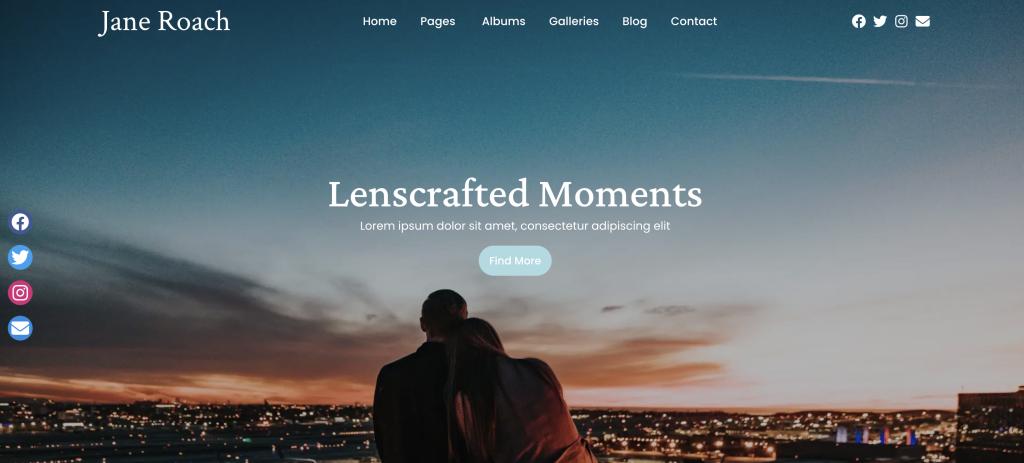Importance of a Portfolio Website
In today’s digitally connected world, having a portfolio website is more than just a trend; it’s a necessity. Whether you’re a freelancer, artist, entrepreneur, or professional, a portfolio website serves as a digital business card. It showcases your skills, talents, and achievements, allowing potential clients or employers to understand what you can offer. It’s a platform where you can express your unique style and personality.
Significance of the Right Name
Choosing the right name for your portfolio website is a critical decision. The name is often the first thing people notice, and it can leave a lasting impression. A well-chosen name resonates with your brand, reflects your identity, and can even enhance your online visibility. It’s not just about picking something catchy; it’s about selecting a name that aligns with your goals, values, and target audience.
Purpose of the Article
This article aims to guide you through the multifaceted process of naming your portfolio website. From understanding your brand and analyzing your target audience to brainstorming ideas and legal considerations, we’ll cover all the essential steps. We’ll also explore how platforms like Grigora can make the process seamless and effective. Whether you’re starting from scratch or rebranding, this comprehensive guide will provide you with the insights and tools you need to name your portfolio website with confidence.
Understanding Your Brand and Identity
Identifying Your Personal or Business Brand
Your portfolio website’s name should be a reflection of who you are and what you do. Whether it’s a personal portfolio or represents a business, understanding your brand is the first step in the naming process.
Define Your Core Values: What are the principles that guide you or your business? Identifying these can help you find a name that resonates with your ethos.
Understand Your Unique Selling Proposition (USP): What sets you apart from others in your field? Your USP can be a key element in choosing a name that stands out.
Analyze Your Target Audience: Who are you trying to reach with your portfolio website? Understanding your audience’s needs and preferences can guide you in selecting a name that appeals to them.
Visualize Your Brand Personality: Are you formal, creative, playful, or serious? Your brand’s personality should be reflected in the name you choose.
Consider Your Industry and Niche: The industry you operate in may have specific naming conventions or expectations. Being aware of these can help you align your name with industry standards.
Think About Long-Term Goals: Your portfolio website’s name should be able to grow with you. Consider your long-term goals and ensure that the name is flexible enough to accommodate future changes.
Leverage Tools and Platforms: Platforms like Grigora offer tools and insights that can assist you in understanding your brand and finding the perfect name.
By taking the time to identify your personal or business brand, you lay the foundation for a name that is not only memorable but also meaningful. It’s a process that requires introspection, creativity, and strategic thinking, but the result is a name that truly represents you and your brand.
Target Audience Analysis
Identifying Your Target Audience
Understanding who you want to reach with your portfolio website is crucial. Your target audience influences not only the content but also the name of your site.
Define Your Ideal Viewer: Who are the people most likely to be interested in your work or services? Understanding their demographics, interests, and needs will guide your naming process.
Analyze Their Preferences: What appeals to your target audience? Are they more inclined towards professional, creative, or quirky names? This insight helps in tailoring the name.
Tailoring the Portfolio Name to Appeal to the Audience: Your portfolio’s name should resonate with your audience. It should reflect what they are looking for and what they value.
By identifying your target audience and understanding their preferences, you can choose a name that speaks directly to them, enhancing the connection and engagement with your portfolio.
Brainstorming Ideas

Techniques for Brainstorming Creative Names
Coming up with the perfect name requires creativity and a systematic approach. Here’s how you can brainstorm effectively:
Mind Mapping: Start with a central idea and branch out with related terms, concepts, and associations. This visual approach can spark creativity.
Use Thesaurus and Naming Tools: Tools like a thesaurus or specialized naming software can help you find synonyms, related words, and creative combinations.
Collaborate with Others: Sometimes, a fresh perspective can lead to unexpected and exciting ideas. Collaborate with friends, colleagues, or even potential audience members.
Consider Using Platforms like Grigora: Platforms that specialize in content management and website creation often have tools and resources for name generation. They can provide insights and suggestions tailored to your needs.
Evaluate and Refine: Not all ideas will be winners. Evaluate them based on how well they align with your brand, audience, and goals. Refine and iterate until you find the perfect fit.
Brainstorming creative names is a process that requires time, effort, and a willingness to explore various avenues. By employing different techniques and leveraging available tools and resources, you can find a name that is not only unique but also a true representation of your portfolio.
Incorporating Keywords
Importance of SEO-Friendly Names
In the digital age, having an SEO-friendly name for your portfolio website is not just an option; it’s a necessity. Here’s why:
Enhanced Visibility: SEO-friendly names help your portfolio rank higher in search engine results, making it easier for potential clients or employers to find you.
Relevance to Your Field: By incorporating keywords related to your profession or industry, you signal to search engines and users alike what your portfolio is about.
Alignment with User Search Habits: People often search using specific keywords. Having those keywords in your portfolio’s name can increase the chances of your site appearing in relevant searches.
Utilizing Platforms like Grigora: Platforms like Grigora, which specialize in content management and website creation, often provide SEO tools and guidance. They can assist in choosing and implementing SEO-friendly names.
Choosing Relevant Keywords for Your Portfolio
Selecting the right keywords is a critical step in naming your portfolio. Here’s how you can approach it:
Identify Core Concepts: What are the main themes, skills, or services showcased in your portfolio? These can guide your keyword selection.
Research Industry Terms: Look at what terms are commonly used in your industry or field. These can be valuable keywords.
Use Keyword Research Tools: Tools like Google’s Keyword Planner can help you find popular and relevant keywords for your portfolio.
Consider Long-Tail Keywords: Sometimes, more specific phrases (long-tail keywords) can be more effective in reaching a niche audience.
Evaluate and Test: Try different keywords and evaluate their effectiveness. Consider how they resonate with your target audience and how they perform in search engine rankings.
Incorporating keywords into your portfolio’s name is a strategic decision that can significantly impact your online presence and success. By understanding the importance of SEO-friendly names and carefully choosing relevant keywords, you can create a name that not only reflects your brand but also enhances your visibility online.
Checking Availability
Checking Domain Name Availability
When naming your portfolio website, it’s essential to ensure that the desired domain name is available. Here’s how to approach it:
Use Domain Search Tools: Websites like GoDaddy or Namecheap offer tools to check if a domain name is available.
Consider Different Extensions: If your preferred .com domain is taken, explore other extensions like .net, .design, or .portfolio.
Think About Variations: If the exact name is taken, consider slight variations that still convey your brand.
Align with Your Brand: Ensure that the domain name aligns with your brand and doesn’t confuse your audience.
Considerations for Social Media Handles
Your portfolio’s name should ideally be consistent across social media platforms. Here’s what to consider:
Check Availability on Major Platforms: Use tools to check if your desired handle is available on platforms like LinkedIn, Twitter, Instagram, etc.
Maintain Consistency: Try to keep the same handle across different platforms for brand consistency.
Consider Abbreviations or Variations: If the exact name is taken, think creatively to find a suitable alternative.
Legal Considerations
Trademark Searches
Before finalizing your portfolio’s name, it’s wise to conduct a trademark search. Here’s why:
Avoid Legal Conflicts: Ensure that the name isn’t already trademarked by another entity in your industry.
Understand Trademark Classes: Trademarks are categorized into classes. Understand which class is relevant to your field.
Consider Professional Assistance: Legal professionals can help conduct a thorough search and guide you through the process.
Legal Compliance in Naming Your Portfolio
Avoid Misleading Names: Ensure that the name doesn’t mislead or misrepresent your services.
Consider Local Regulations: Different jurisdictions may have specific rules about business naming. Be aware of these as they apply to your location.
Document Your Use: Keep records of your use of the name, as this can be important in legal situations.
Checking availability and considering legal aspects are crucial steps in naming your portfolio website. They ensure that your chosen name is unique, aligns with your brand, and complies with legal norms. These considerations help in building a strong foundation for your online presence, avoiding potential conflicts, and reinforcing your brand identity across various platforms.
Testing the Name
Choosing the right name for your portfolio website is a critical decision, and testing it before finalizing can provide valuable insights. Here’s how to approach this phase:
Gathering Feedback from Peers and Potential Clients
Identify Key Stakeholders: Determine who your peers, potential clients, or other stakeholders are that can provide meaningful feedback.
Create a Survey or Questionnaire: Develop a set of questions to gauge reactions to the name. Include open-ended questions for qualitative insights.
Conduct Interviews or Focus Groups: Engage with individuals or small groups to gather in-depth feedback.
Analyze the Feedback: Look for common themes, positive reactions, and concerns. Consider how the name aligns with your brand and resonates with your audience.
Make Necessary Adjustments: Based on the feedback, make any necessary adjustments to the name or how it’s presented.
A/B Testing for Online Reactions
Develop Different Variations: Create two or more variations of the name or how it’s presented on your website.
Use A/B Testing Tools: Utilize online tools that allow you to present different versions to different visitors.
Monitor Reactions and Engagement: Track how visitors engage with each version. Look at metrics like time on page, click-through rates, and conversions.
Analyze the Results: Determine which version resonates more with your online audience.
Consider Broader Testing: If the results are inconclusive, consider broader testing or additional variations.
Testing the name of your portfolio website is a strategic step that helps ensure that your chosen name resonates with your target audience and aligns with your brand’s identity. By gathering feedback from relevant stakeholders and conducting A/B testing, you can validate your choice and make informed decisions. This process helps in fine-tuning the name, understanding how it’s perceived, and ultimately selecting a name that will support your portfolio’s success in the online world.
Integration with Design and Content
The name of your portfolio website is more than just a label; it’s an integral part of your brand’s identity. Aligning the name with the website’s design and content ensures a cohesive and harmonious user experience. Here’s how to achieve this alignment:
Aligning the Name with the Website’s Design
Understand Your Brand’s Visual Identity: Identify the visual elements that define your brand, such as colors, typography, and imagery.
Create a Logo or Visual Representation: If applicable, design a logo or visual element that incorporates the name and aligns with the overall design theme.
Ensure Consistency Across Pages: Use consistent design elements that complement the name across different pages and sections of the website.
Consider User Experience (UX): Ensure that the name and associated design elements enhance the user experience, not detract from it.
Test Design Integration: Gather feedback on how well the name integrates with the design from both a visual and usability perspective.
Creating a Cohesive Visual and Textual Identity
Align Content with the Name’s Message: Ensure that the content on your website reflects and supports the message or theme conveyed by the name.
Use Consistent Tone and Voice: Maintain a consistent tone and voice in all textual content that aligns with the name and overall brand identity.
Incorporate the Name into Key Areas: Consider using the name or associated keywords in headings, taglines, or other prominent areas to reinforce the brand.
Create Supporting Visual Content: Develop images, videos, or other visual content that complements the name and enhances the overall narrative.
Evaluate the Overall Cohesiveness: Review the entire website to ensure that the name, design, and content work together to create a unified and engaging experience.
Integrating the name with the design and content of your portfolio website is a vital step in building a strong and recognizable brand. By aligning the name with the website’s design and creating a cohesive visual and textual identity, you craft a seamless experience for your visitors. This integration not only enhances the aesthetic appeal but also reinforces the message and values that your portfolio represents. It’s about creating a harmonious connection between the name, design, and content that resonates with your audience and leaves a lasting impression.
Utilizing Grigora for Portfolio Creation
In the world of digital portfolios, having a platform that offers flexibility, creativity, and ease of use is paramount. Grigora stands out as an innovative platform that empowers users to create stunning portfolio websites. Here’s how Grigora can be a game-changer in the naming and design process of your portfolio:
Introduction to Grigora as a Platform for Portfolio Websites
User-Friendly Interface: Grigora offers a user-friendly interface that makes it accessible to everyone, from beginners to seasoned professionals.
Wide Range of Customization Options: With Grigora, you can tailor your portfolio to fit your unique brand and identity, including the name, design, layout, and content.
Robust Security Measures: Grigora ensures that your portfolio is secure, providing peace of mind as you showcase your work online.
Diverse Use Cases: Whether you’re an artist, freelancer, small business owner, or educator, Grigora offers solutions that cater to various needs and industries.
How Grigora Can Enhance the Naming and Design Process
Integrated SEO Tools: Grigora’s SEO-friendly features can guide you in incorporating relevant keywords into your portfolio’s name, enhancing visibility online.
Creative Design Templates: Grigora offers a plethora of design templates that can align with your chosen name, creating a cohesive visual identity.
Real-Time Preview and Editing: Experiment with different names and designs with Grigora’s real-time preview and editing capabilities, allowing for a seamless creative process.
Collaboration and Feedback Tools: Collaborate with team members or gather feedback from peers directly within Grigora, ensuring that the name and design resonate with your target audience.
Scalability and Growth: As your portfolio grows, Grigora’s scalable solutions can adapt to your evolving needs, keeping your name and design relevant and engaging.
Some of the Portfolio Templates Available with Grigora
Cornelia Rasco’s Portfolio

Cornelia Rasco’s Portfolio Template offers a clean and elegant design, perfect for showcasing visual works. It includes sections for portfolio, about, services, and contact.
Austin Ryan’s Portfolio

Austin Ryan’s Portfolio Template features a vibrant and interactive design, suitable for UI/UX designers. The clear navigation allows for easy exploration of projects and skills.
Jane Roach’s Portfolio

Jane Roach’s Portfolio Template provides a minimalist design that focuses on content. It’s ideal for writers or content creators, with sections for samples, services, and testimonials.
Joseph Powell’s Portfolio

Joseph Powell’s Portfolio Template is sleek and professional, designed for software developers or tech professionals. It includes sections for projects, skills, experience, and a blog.
Dustin Gibson’s Portfolio

Dustin Gibson’s Portfolio Template emphasizes visual appeal, suitable for digital branding and graphic designers. It details services such as Layout Design, Digital Illustration, UX Design, and more.
These templates demonstrate the versatility and creativity that Grigora offers, allowing users to create stunning websites tailored to various professions and needs.
Case Studies and Examples
The name of a portfolio website is more than just a label; it’s a reflection of your brand, your work, and your identity. A well-chosen name can captivate your audience, convey your uniqueness, and leave a lasting impression. Let’s explore some successful portfolio website names and analyze what makes them effective:
Successful Portfolio Website Names
JessicaHische.is:
A personal branding approach using the creator’s name. It’s straightforward, professional, and memorable.
TimRoussilhe.com:
This portfolio showcases the quirky and interactive design style of Tim Roussilhe.
PierreNel.co.uk:
By using his name, Pierre Nel creates a personal connection with visitors to his portfolio site.
AdhamDannaway.com:
A blend of web design and development skills is showcased in this creatively designed portfolio.
PixelPerfectPortfolios.com:
Using alliteration and industry jargon (“Pixel Perfect”), this name is catchy and directly related to graphic design.
These examples showcase different strategies for naming a portfolio website, reflecting the individual’s or company’s unique brand, field, and creativity.
Analysis of What Makes Them Effective
Relevance: Each name is closely tied to the field or industry, providing immediate context to the audience.
Uniqueness: These names stand out by incorporating personal touches, clever wordplay, or industry-specific terms.
Memorability: Simplicity, alliteration, and creativity make these names easy to remember.
SEO-Friendly: By including keywords related to the field, these names enhance online visibility.
Alignment with Brand: The names resonate with the brand’s identity, values, and offerings, creating a cohesive image.
Legal Compliance: These names are likely checked for trademark issues and domain availability, ensuring they are legally sound.
Adaptability: The names are versatile and can adapt to various design aesthetics and content strategies.
FAQs on How to Name Your Portfolio Website
How do I start naming my portfolio website?
Identify your brand and target audience, brainstorm keywords, and use creativity. Tools like Grigora can help.
How do I ensure the name is legally available?
Search trademark databases, check domain availability, and consult with a legal professional if needed.
Should I include my name in my portfolio website’s name?
It depends on your brand and goals. Your name adds a personal touch, but a creative name might be a better fit.
Can I change my portfolio website’s name later?
Yes, but it can affect SEO and brand recognition. Plan carefully if a change is necessary.
How do I make the name SEO-friendly?
Incorporate relevant keywords, keep it simple, and use tools like Google’s Keyword Planner for guidance.
Conclusion
Naming your portfolio website is a critical step in establishing your online presence. It’s not just about choosing a catchy phrase; it’s about understanding your brand, identifying your target audience, incorporating SEO-friendly keywords, and ensuring legal compliance. Tools like Grigora can simplify the process, allowing you to create a name that resonates with your audience and aligns with your goals.
By following the guidelines outlined in this article, you can craft a name that not only stands out but also serves as a cohesive part of your overall brand identity. Whether you’re a freelancer, artist, or small business owner, the right name can set the tone for your portfolio and pave the way for success in the online world.



